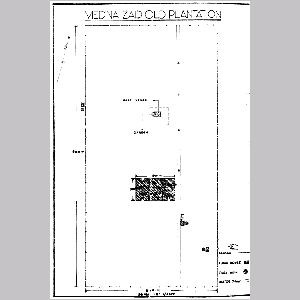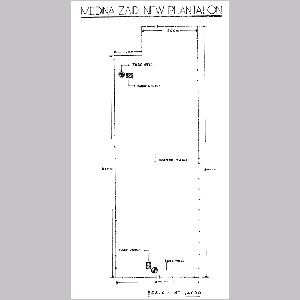Bulletin 11 - July 1980: Median Zayed Plantation
Median Zayed Plantation
by M.I.R. KhanForestry Expert
Introduction
Median Zayed plantation is an important and interesting plantation raised in the Western Region of Abu Dhabi. It is a twin plantation covering an area of 44.5 hectares and is situated at a distance of about 12 kilometers from the new township of Beda Zayed coming up along the Tarif-Liwa asphalt road and only at a short distance of about two kilometers to the south of Sheikh Mohammed bin Butti's village which is connected to Beda Zayed by an asphalt road. The plantation is in two parts located in two closely adjoining small valleys at the foot of rolling sand hills running more or less parallel from the east to the west. The two plantations were completed during 1977 and 1978, respectively.
First plantation
The first plantation lying to the east of the second plantation covers an area of 18 hectares. The raising of tree species was taken up in it during 1976 using grown water from a solitary tube well that had been bored within the plantation area some time ago. A small nursery measuring 120 m by 60 m was also set up in this plantation near the tube well at the same time to raise tree seedlings and to try growing of vegetables. The ground water from the tube well containing total dissolved salts between 5000 to 6000 parts per million (ppm) was not found quite suitable for growing both tree seedlings and vegetables. During 1977, another tube well was bored to the west of this plantation and this luckily yielded comparatively better quality water containing total dissolved salts of around 4000 ppm. Water from this well is now being used for irrigation purposes in the nursery. Tree seedlings of Ghaf (Prosopis spicigera), Samar (Acacia tortolis), Qarat (A. Arabica), Sidr (Zizyphus spinachristi), Eucalyptus, Casurina and Atriplix etc in thousands are being raised in this nursery. It has also been possible to do vegetative propagation of branch cuttings of Daphla (Nervium odoratum), Zafar Yasmin (Clerodendron interme), Arta (Calligonum comosum), Tamarisk and Bogainvillea. This nursery can hold from 20,000 to 30,000 tree seedlings and saplings and is producing about 60,000 saplings annually.
Both winter and summer vegetables such as tomatoes, egg plant, cauliflower, cabbage, carrots, Lady's finger, lettuce, radishes, turnips, watermelons, musk melons, onions, garlic, beetroot, sweet potatoes, etc and fodder crops like Jat (Lucerne), Zahra (Sorgham), Zarra (Maize) and Saibu (Millet) are being raised successfully within the nursery. Recently fruit plants of Purtgal (orange), Lumi (lemon), Kinnow, grafted Sidr, Rumman (Pomegranate), Zaitum (olive) and Guava have also been planted in the nursery and sheltered locations in the plantation and the Rest House compound. The fruit plants have put on good growth so far and their further progress is being keenly watched.
Rest HouseThe first plantation also has a small Rest House that consists of two bedrooms, a dining room/sitting room, a kitchen and two detached bathrooms. It is located almost in the middle of the plantation on a small hillock and gives a clear view of the plantation and the sand hills around. On a clear starry night, the glare of the flared up gas in Bu Hassa, Habshan and Al Asab oil fields is prominently visible in three directions from the Rest House. An elevated green grassy lawn has been developed to the west of the Rest House building. Sitting in this plot one can get a good view of the plantation and the Meteorological Station and it is a useful spot for bird watching.
The Rest House compound on four sides is lined with live shelterbelts raised with the trees of Casurina and Tamarisk trees. On the inside of the shelterbelt, plants in groups of three of a number of local and exotic tree species such as Ghaf, Samar, Sidr, Salam (Acacia raddiana), exotic Acacias, Albizzia, Butea, Callistimone, Casurina, Eucalyptus, Ficus, Nelias, Parkinsona, Pithicolobium, Podocarpus, Pongamia, and Terminalia have been raised. This small arboretum around the Rest House would be very useful in comparing the performance of the above listed species under desert conditions. More recently, a few plants of fruit trees of orange, kinnow, grafted Sidr, pomegranate and olive have also been planted in the Rest House compound.
Planting Stock of First PlantationThe planting stock of this plantation consists of over 3000 trees of Guaif (Prosopis juliflora), Ghaf, Qarat, Sidr, Salam and Samar and 1612 trees of date palm (Phoenix dactylifera). About 22 of the date palms are male trees. The date palms started bearing fruit only two years after being transplanted and last year produced 1500 kilos of dates. Both the tree species and the date palms have been planted at a spacing of 6 m by 6 m in this plantation.
In between the tree species, over 4000 plants of fodder like Atriplex, Arta and Markh (Leptadenia pyrotechnica) have been added during 1978 and 1979 to produce forage for the domestic livestock. Plants are irrigated by drip irrigation. The date palms are, however, provided irrigation by flooding with hose water once a week.
Second PlantationThe second Medina Zayed plantation lies across a sand hill to the west of the first plantation and covers an area of 26.5 hectares. The site was leveled, fenced and laid out in 1977 and it was planted during 1978. It is planted entirely with local tree species at a spacing of 7 m by 7 m. Over 5000 plants of Ghaf, Qarat, Sidr and Salam have been planted in blocks in this plantation. The irrigation water, obtained from two deep wells, is supplied to the plants by trickle irrigation. The system is designed and geared to provide 10 gallons of water to each plant every day.
In order to produce forage for the domestic livestock planting in between the trees has been done with fodder species such as Atriplex, Arta and Markh. The plantation now has about 5000 bushes of these fodder species. They are cut repeatedly to produce fodder to livestock. A small rock mound made artificially by collecting large pieces of rock and stones in the middle of the plantation has been planted with ornamental species like Casurina, Nerium adoratum and Tecoma stans bushes. Nerium is also planted in the two avenues running across the plantation to add some color to the greenery of the plantation.
Meteorological StationAn agro-meteorological station (WMO Station No. 40442) located in between the two plantations on a sand dune of medium elevation at latitude 23°37"N and longitude 53°37"E and at an altitude of 130 m above mean sea level was established in 1978 to record the agro-meteorological and climatic data for the region. Daily observations on air temperatures, soil temperatures, humidity, rain fall, evaporation, air pressure, sunshine, solar radiation and wind velocity are recorded. A copy of the month-wise observations recorded at this station is also sent to International Aeradio Ltd. (I.A.L.).
The station is providing useful information in planning our future plantation and agricultural operations in the region. The meteorological data recorded at the station would be useful for weather forecasting in the future.
Recovery of Natural Flora and FaunaInside the two blocks of the plantation which are fenced and as such cannot be trampled and grazed or browsed by stray domestic animals there has been a remarkable recovery of the local flora and fauna. Plants of the Rims (Haloxylon salicornicum), Harm (Zygophyllum sps), Khadrar (Cyperus longus), Thamam (Panicum turgidum) have made a steady recovery and are providing good soil cover in many places. The plantation is also frequented by the wild hare (Lepis capensis), ravens, doves and other birds and a variety of insects.
The plantation can be easily visited by driving down the asphalt road from Beda Zayed to Sheikh Mohammed's village and then either by riding in a vehicle with four wheel drive or by walking on foot over a distance of only two kilometers from the Sheikh's village.

